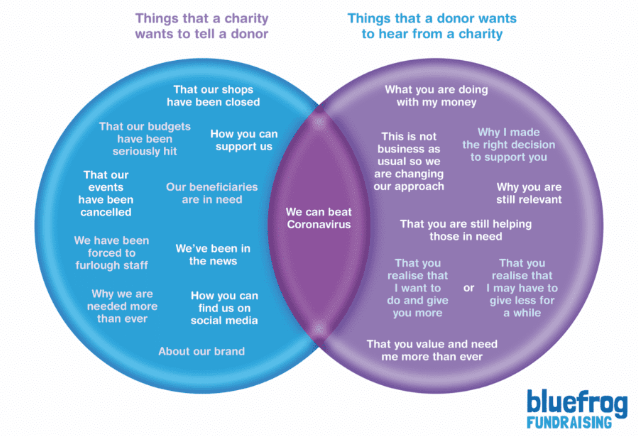Philanthropy Trends Your Nonprofit Needs to Know Mid-Pandemic
 Could you be getting it all wrong when it comes to the what, who, where, why, how and when of your nonprofit’s communications and fundraising as this pandemic plays out?
Could you be getting it all wrong when it comes to the what, who, where, why, how and when of your nonprofit’s communications and fundraising as this pandemic plays out?
You could.
Especially if you’re leading from opinion above knowledge. You know, going with your gut when it comes to what your donors want or need from you right now. Otherwise known as guessing.
That’s never a good idea for someone whose job is to facilitate philanthropy. Because a lot is known about how much joy it brings people to demonstrate their ‘love of humanity’ through philanthropic acts. Your gut telling you donors don’t want to be invited to become heroes? P’shaw.
Now, thanks to the folks at Blue Frog Fundraising, more is known about how donors feel about giving in response to the current pandemic. In the recently revealed Coronavirus Research Findings: What do donors think now? they focus on what donors have told them about how their approach to giving has changed. Or hasn’t.
These philanthropy trends are important to understand, so I’ve selected the most salient among their key findings (highlighted in the break-out boxes) and have grouped them according to the traditional journalist’s rubric of what, who, where, why, how and when.
 I’m going to explain what your nonprofit should do to show donors you do, in fact, understand where they’re coming from.
I’m going to explain what your nonprofit should do to show donors you do, in fact, understand where they’re coming from.
Before taking any marketing message or fundraising appeal off your plate, and before adding anything new, always make sure to ask yourself these six important questions! They will help you assess almost any situation, plus focus your efforts and aid you in telling more relevant, compelling stories.
Let’s get started…
Details




 Last week I shared a number of real-life examples from innovative nonprofits taking creative steps to connect meaningfully to their supporters during these trying times. While staying connected, some organizations are succeeding in stepping up both their marketing and fundraising communications to the next level.
Last week I shared a number of real-life examples from innovative nonprofits taking creative steps to connect meaningfully to their supporters during these trying times. While staying connected, some organizations are succeeding in stepping up both their marketing and fundraising communications to the next level.

 If you’re like me, chances are every other email in your inbox has something referencing coronavirus. You can’t ignore it, avoid it or wish it away.
If you’re like me, chances are every other email in your inbox has something referencing coronavirus. You can’t ignore it, avoid it or wish it away.


 Wondering where fundraising is heading in our highly networked, overly saturated, noisy-as-all-get-out post-digital revolution world?
Wondering where fundraising is heading in our highly networked, overly saturated, noisy-as-all-get-out post-digital revolution world?